Exploring Bento Food: History, Culture, and Modern Variations
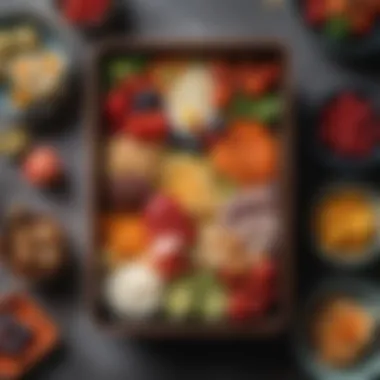
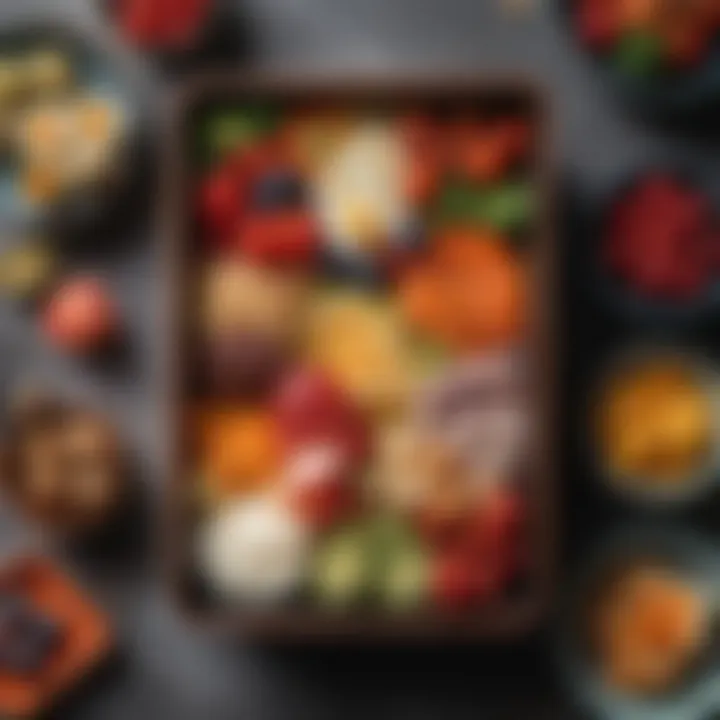
Intro
In a world where fast-paced lifestyles often dictate our meal choices, the art of bento food stands as a delightful counterpoint. This culinary concept, originating in Japan, is a harmonious blend of taste, nutrition, and aesthetics. Each bento box tells a story, reflecting not just the ingredients but the culture and creativity behind the meal.
Exploring bento food offers insights into how flavors can be artfully arranged, enhancing not just the dining experience but also the nutritional value. This journey goes beyond just filling a box with random foods—instead, it moves towards thoughtfully curated meals that cater to different tastes, dietary needs, and even seasonal ingredients. It’s about creating a little masterpiece that can be enjoyed on the go, whether at a workplace, school, or during a picnic.
By delving into its historical roots, we uncover a narrative that intertwines food with tradition, showing how generations have adapted this concept to fit modern lifestyles. In this article, we will journey through the essentials of bento, from the basic recipes to the nutritional benefits of these compact meals, making it easier for anyone to embrace this culinary art.
Let's start our exploration with a closer look at how to craft the perfect bento box.
Intro to Bento Food
Bento food, at its core, is not just a meal; it’s a tradition that spans centuries. Understanding this culinary phenomenon opens doors to appreciating its multifaceted nature. In this article, we will peel back the layers of bento, revealing not only its historical significance but also its practical applications in today’s fast-paced world. A bento box elegantly packages diverse foods, transforming everyday meals into visually stunning culinary art. This is key, because the visual appeal often tempts even the pickiest eaters. Moreover, bento provides a convenient way to ensure that meals are well-balanced, providing variety while considering portion sizes and nutrition.
Defining Bento
Bento refers to a single-portion takeout or home-packed meal. In Japan, the term has become synonymous with a well-packed lunch, often consisting of rice, meat or fish, and pickled or cooked vegetables. However, the charm of bento lies beyond mere definition. It encourages culinary creativity while allowing individuals to reflect personal taste and preferences. A typical bento box might include neatly arranged rice balls, delicate sushi, vibrant vegetables, and perhaps a small sweet treat, all artfully presented. This arrangement isn't accidental; each color and shape works together to create a meal that’s easy on the eyes and palate.
Cultural Roots of Bento
Bento is steeped in rich cultural heritage. Its origins trace back hundreds of years, evolving with the lifestyle of the Japanese people. Historical records suggest that bento boxes started in the Kamakura period, where travelers would bring meals prepared in simple containers. As time passed, the art of bento captured the attention of the public and became more elaborate, especially during the Edo period. Families began to create festive bento meals for special occasions, often reflecting seasonal changes and celebrations.
Additionally, bento serves as a medium for expressing love and care. For instance, a mother might craft intricate character bentos for her child's lunch, known as kawaii bento, which means ‘cute.’ This not only fuels the child’s appetite but also illustrates the depth of parental affection.
In recent years, the global interest in bento has surged. As people from various cultures engage with this practice, they introduce personal twists to classic bento recipes, blending traditional and modern influences. This adaptability marks bento’s ongoing evolution, showcasing how deeply it is rooted across cultures, transcending mere food to embody a way of life.
Historical Context
Understanding the historical context of bento food offers a lens into its origins and evolution. The bento box is not merely a vessel for holding food; it reflects centuries of culinary artistry and cultural practices that have shaped Japanese society. This historical perspective allows us to appreciate how flavors, traditions, and societal needs have been interwoven through time.
The development of bento is a story of adaptation and personalization. The bento box has transitioned from a simple meal solution to a colorful and artfully arranged showcase of culinary skills. Exploring these transformations reveals significant cultural shifts and the practicality that bento embodies, which continues to resonate with contemporary culinary enthusiasts.
The Evolution of Bento Boxes
The journey of the bento box has been quite intriguing. Its origins can be traced back to the late Heian period (794-1185), a time when nobles enjoyed elaborate picnic meals known as "makunouchi". These were often presented in beautiful lacquered boxes, emphasizing both aesthetics and flavor. Over the centuries, the practicality of bento boxes grew alongside Japan's shifting economic landscape.
In the Edo period (1603-1868), bento became more accessible to the general populace. Street vendors began selling rice boxes filled with various sides, catering to the burgeoning merchant class. This democratization of bento food illustrates its availability to all walks of life, allowing anyone to enjoy a nutritious, portable meal on the go.
As we traveled through time, innovative designs and materials began to emerge. From the traditional wooden boxes to modern plastic designs, these containers reflect not only functional needs but also changing societal tastes. Changing times ushered in creative bento styles, such as kyaraben, where meals are crafted to resemble characters from movies and games. This trend showcases how bento evolved into a canvas for creativity, appealing especially to young families.
Bento Throughout Japanese History
Delving deeper into Japanese history, bento food has played a role in several social and cultural movements. During the Meiji Restoration (1868), Japan opened its doors to the West. This period brought about immense changes in dining habits, and bento evolved further with influences from Western cuisine. Lunch boxes started to incorporate ingredients and styles influenced by Western cooking, adding variety and changing perceptions of traditional Japanese meals.
In post-World War II Japan, the significance of bento food took on new meaning. As the nation rebuilt, bento became a symbol of resilience and adaptation. The necessity for economical, nutritious meals led to mass production of bento boxes for school children and office workers. It served as a reminder of home-cooked meals, fostering connection to one’s roots regardless of the modern influences surrounding them.
"Bento is more than food; it’s a slice of history served in a box. It embodies resilience, creativity, and the essence of Japanese culture, transcending time and society."
Today, the legacy of bento continues to thrive. It embodies a blend of tradition and contemporary influences. With bento food now finding a place on global dining tables, it remains a remarkable example of how culinary practices can evolve while maintaining their core essence. Understanding this evolution enables modern-day cooks and enthusiasts to appreciate the intricate dance between culture and cuisine.
Components of a Bento Box
The bento box is more than just a simple meal container; it's a carefully curated experience that combines flavor, nutrition, and presentation. Understanding the components of a bento box is essential to grasping its significance in culinary traditions and contemporary meal planning. Every element in the box not only serves a purpose but also contributes to the overall enjoyment and satisfaction of the meal.
Essential Ingredients
At the heart of any bento box are its essential ingredients. These ingredients vary widely, influenced by regional preferences, seasonal availability, and dietary choices. However, three foundational staples can often be found in traditional and modern bento boxes alike:
- Rice: Often referred to as the cornerstone of a bento meal, rice is more than a filler. Whether it’s plain white rice, seasoned rice, or sushi rice, its texture and flavor can ground the entire meal. While Japanese short-grain rice is commonly used, alternatives like brown rice or quinoa are emerging among health-conscious individuals.
- Proteins: Protein sources range from fish, poultry, and meat, to vegetarian options like tofu or lentils. Packed with essential amino acids, proteins enhance flavor and provide the necessary nourishment to tackle the day ahead. Grilled salmon or teriyaki chicken are popular choices, but creative cooks experiment with spiced chickpeas or marinated tempeh.
- Vegetables: A bento box is often a riot of colors, with vegetables offering both health benefits and visual appeal. Common picks include steamed broccoli, pickled radishes, or sautéed spinach. Incorporating a variety of textures and colors not only makes for a more delicious meal but also serves to engage the eaters' senses.
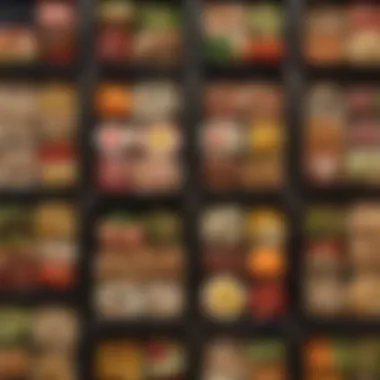
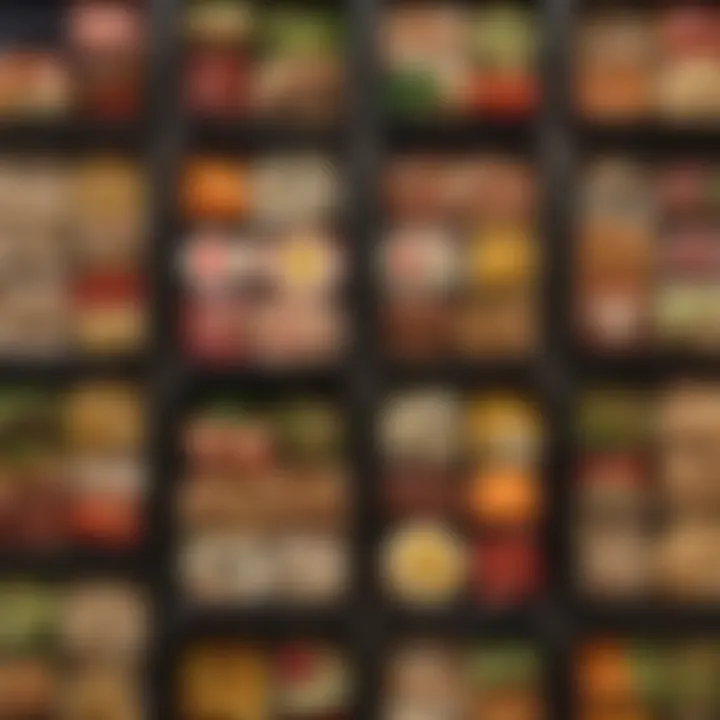
Beyond these staples, bento boxes can showcase seasonal ingredients, adding a touch of variety and freshness. As the saying goes, "you eat with your eyes first," meaning that presentation plays a crucial role in the appeal of a bento.
Balancing Nutrition
When assembling a bento box, balancing nutrition should take precedence. Many people often overlook this crucial aspect, believing that any combination of ingredients will suffice. By thoughtfully considering nutritional balance, you can create a meal that fuels the body without feeling overwhelming. Here are a few guiding principles:
- Portion Size: Aim for a well-rounded bento that includes moderate portions of carbohydrates, proteins, and fats. A typical bento layout encourages a balance where rice or grain takes up approximately one-third of the box, proteins another third, and vegetables fill the remaining space.
- Diverse Nutrients: Incorporating an array of colors translates to a wider range of vitamins and minerals. Including leafy greens, bright oranges, and deep reds not only pleases the eye but also enriches the meal with varied health benefits.
- Consider Preferences: Individual dietary needs and preferences matter when preparing bento. For instance, someone may require gluten-free options or might be vegetarian. Tailoring the assortment to accommodate these factors ensures that every meal is both enjoyable and health-conscious.
By keeping these considerations in mind, the bento box becomes more than just a meal—it becomes a personalized experience that respects both culinary traditions and individual preferences.
Diversity in Bento Styles
The world of bento is as varied as the ingredients that fill its boxes. This diversity not only celebrates a spectrum of flavors, but it also reflects the creative tendencies of those who prepare them. Whether it's a simple lunch packed for work or an elaborate spread for a holiday, bento styles often adapt to cultural influences and personal preferences. Understanding this diversity in bento means delving deeper into how the foundation of traditional Japanese bento has evolved and merged with other culinary traditions over time.
Traditional Japanese Bento
At the heart of bento culture lies the traditional Japanese bento, known as eki-ben when sold at train stations. This type of bento is an art form in its own right, meticulously crafted to appeal both visually and palatably. The components typically include an array of colorful items—rice, pickles, grilled fish, and seasonal vegetables—all arranged beautifully in a compact box. This intricate presentation is not merely for aesthetics; it reflects the Japanese value of balance. A traditional bento aims for harmony in flavor, color, and nutritional value, symbolizing respect for ingredients and the seasons.
A classic example would be the shinobumaru, a bento filled with seasonal ingredients and accompanied by miso soup. The objective is to provide a wholesome meal that nourishes both body and soul.
"In a traditional Japanese bento, every bite tells a story—of culture, nature, and meticulous preparation."
Western Influences on Bento
As culinary boundaries blur, Western influences have crept into bento boxes, creating a unique fusion that marries tradition with modern convenience. Today, you may find turkey sandwiches alongside edamame and sushi rolls in a single box, exemplifying a melding of resources and traditions.
This adaptation reflects lifestyles that prioritize both nutrition and convenience, catering to busy individuals who still desire to enjoy meals that are aesthetically pleasing and culturally rich. For instance, a bento with pasta salads and grilled chicken served with recognizable dips like ranch or hummus not only satisfies familiar cravings but also respects the bento form by maintaining portion control and balance.
Fusion Bento Ideas
Fusion bento takes the art of bento one step further, allowing aficionados to experiment freely with flavors and presentations from different cuisines. Imagine tacos in a bento box, a daring combination of Mexican and Japanese styles that can include seasoned chicken, avocado, and a side of sushi rice. The potential is boundless.
Another inventive idea could be a Mediterranean bento, featuring items like falafel, tzatziki, and a small salad of roasted vegetables. This approach not only enhances flavor profiles but makes the bento experience more versatile.
Incorporating creative elements, bento can include:
- Homemade spring rolls filled with Thai flavors
- Savory quiches reminiscent of French picnics
- Rice paper wraps that carry Vietnamese freshness
These options illustrate how bento transcends its traditional roots while remaining a source of nourishment and enjoyment.
Diversity in bento, therefore, is not just about different dishes or styles; it's about celebrating adaptability, acknowledging that food culture can evolve while retaining its core values of beauty, balance, and satisfaction.
The Art of Bento Preparation
Preparing bento involves a careful blend of art and science. It's not just about putting food into a box; it’s about crafting a meal that is visually appealing and nutritionally balanced. Understanding how to prepare bento can transform mealtime into an enjoyable ritual. When thought through properly, it can also save time during busy workdays. Those who master these techniques find that bento is not just a meal, but an expression of creativity and tradition.
Planning and Organization
To embark on the journey of bento preparation, meticulous planning is key. Creating a weekly meal plan can simplify your grocery shopping and preparation. This ensures that every meal is well-rounded and not just a random assortment of food. Look at ingredients you already have and factor them into your plan. Make a list, because believe me, a shopping list can be your best friend in keeping things organized.
Incorporating seasonal produce can also enhance your bento, both in flavor and nutritional value. Also, many cultures have home-cooked recipes that can be adapted for bento. The whole process of planning further allows you to explore new tastes while keeping things efficient.
Food that you prepare should be manageable within your usual schedule, so consider picking one day to do the heavy lifting.
Time-Efficient Cooking Tips
Making bento doesn’t have to eat up all your free time. Here are some strategies that can save you time in the kitchen.
Batch Cooking
Batch cooking is a clever approach that many people find useful when preparing bento. This means preparing larger quantities of food in one go, which can then be stored and used in multiple bento boxes throughout the week. One key characteristic of batch cooking is that it greatly reduces cooking time and minimizes the dishes you have to clean.
You can cook staples like grains, proteins, and even vegetables in a single session. Imagine having a big pot of rice ready to go, or grilled chicken waiting in the fridge. It’s a no-brainer for someone looking for convenience and efficiency in meal prep.


However, while there's a lot of upside, one unique feature to note is that some ingredients may lose their freshness over time. So it’s wise to use your batch-cooked goods within a certain time frame.
Storage Solutions
Storage solutions play a vital role in maintaining the quality and space of your bento ingredients. Investing in proper containers can make or break your bento experience. Look for airtight containers that can separate various components of a meal. Not only does this keep flavors from mingling, but it also helps in portion control.
These containers can be stacked neatly in your fridge or freezer. You can even use silicone cupcake liners or dividers to organize smaller items like nuts or cut fruits. Being able to see what you have on hand can prevent waste and keep your meals exciting.
Ultimately, the right storage solutions not only prolong the freshness of your food but also ease the assembly process of your bento, making it a popular choice for both amateur and seasoned cooks.
"Good cooking is the foundation of genuine happiness."
- Auguste Escoffier
Presenting Your Bento
When it comes to the art of bento, how you present it can be just as important as the food itself. The act of arranging food in an appealing way not only enhances the dining experience but can spark joy in the eater. After all, we eat with our eyes first. A well-presented bento box tells a story, showcasing the effort and creativity that went into its making. Neatly arranged colors and textures can stimulate appetite as effectively as the flavors within.
There are several elements that demand attention when presenting your bento. From the colors of the ingredients to the balance of shapes and sizes, all contribute to a favorable visual appeal. Moreover, arranging food in different compartments allows for a variety of tastes and invites the diner to partake in an enjoyable experience.
Aesthetic Considerations
Aesthetic considerations can elevate the ordinary into something extraordinary. Take time to think about the colors on your plate. For instance, pairing vibrant green broccoli with the rich orange of roasted sweet potatoes not only creates a feast for your taste buds but a visual treat as well. Get more playful by layering textures—crunchy, creamy, and chewy, all fitting neatly into a single bento box.
- Color Harmony: Using a color wheel can help identify complementary colors for a more visually appealing meal.
- Texture Variety: Combine different textures, like crispy nori with fluffy rice, for added interest.
- Symmetrical vs. Asymmetrical Arrangement: Experiment with both styles, as symmetry can appeal to traditional aesthetics, while asymmetry can look avant-garde.
In each case, adding a touch of garnish, such as sesame seeds or a small edible flower, can bring your bento presentation to the next level. Reflecting cultural elements by including traditional items like pickled vegetables can transform a simple meal into an experience steeped in cultural significance.
Containers and Utensils
The choice of container is critical in presenting your bento. A well-chosen container complements the food contained within, making the entire presentation cohesive and aesthetically pleasing. Bento boxes come in various shapes and sizes. Depending on the meal and occasion, you might choose a classic Japanese bento box made from lacquer or a more modern, sustainable option like stainless steel or bamboo.
- Material Matters: Different materials offer varying degrees of insulation, aesthetics, and ease of cleaning. For instance, lacquered boxes keep food warm while offering a brilliant shine.
- Compartmentalization: A good bento box usually includes compartments, which helps keep flavors from mingling. This is especially important for dishes with strong flavors.
- Size Considerations: Choose box sizes that cater to the intended meal. For lunch, a box with enough room for a protein, grain, and two veggies is ideal.
Let’s not forget utensils! Choosing appropriate utensils adds to the experience. Chopsticks can enhance the authenticity of the meal, while small forks or spoons may be more convenient for certain dishes. Compact, portable utensils also align nicely with bento’s functional purpose—ideal for on-the-go meals.
"A bento box is not just a meal; it’s an expression of creativity and culinary skill. The details matter."
In summary, every bit of detail in presenting your bento is a reflection of thought and care. From choosing the right container to color mixing on the plate, every choice contributes to the overall meal’s enjoyment. A beautifully arranged bento interacts with the diner, inviting them to savor not only the food but also the artistry behind it.
Health Implications of Bento Food
Bento boxes offer more than just beautiful presentation; they also carry significant health implications that can benefit individuals seeking balanced diets. The thoughtfully curated nature of bento meals can have a positive impact on physical well-being. This section explores key aspects like portion control and dietary considerations inherent in bento, shedding light on how this culinary form supports both health goals and overall nutrition.
Portion Control
One of the hallmarks of bento food is its inherent portion control. Unlike fast food or buffet-style meals, a bento box is designed to provide a well-measured serving of various food groups. This can help in maintaining a balanced diet and preventing overeating, a dilemma often faced in today’s fast-paced society.
- Visual Appeal: The segmented nature of bento boxes allows for distinct portions of protein, vegetables, and carbohydrates. Each compartment creates visual cues, making it easier to gauge appropriate serving sizes.
- Mindful Eating: Enjoying a bento involves appreciation for each component, promoting a mindful eating experience. Individuals often find that they savor their meals more, leading to improved satisfaction and diminished cravings.
- Balanced Nutrition: By combining multiple food types, bento meals facilitate the intake of essential nutrients without the risk of excess. Fruits, vegetables, grains, and proteins all find a place within a single box, making it easier to meet nutritional needs while controlling caloric intake.
"A well-prepared bento can act like a doctor’s prescription for healthy eating: precise portions, balanced ingredients."
Dietary Considerations for Bento
In constructing a nutritious bento, one must be mindful of dietary considerations that align with individual health needs. This customization makes bento boxes particularly appealing in a world where one size rarely fits all.
- Allergies and Sensitivities: With increasing food allergies, having the control to choose what goes into each bento is significant. Many people can tailor their meals to avoid allergens, ensuring they enjoy a meal without worry.
- Nutritional Preferences: Whether one adheres to a vegetarian, vegan, or low-carb diet, bento accommodates a myriad of lifestyles. For instance, a vegan bento can feature tofu, chickpeas, and an array of vegetables.
- Cultural Inspirations: Different cuisines offer diverse options, and bento can embrace these variations. Adding ingredients from cuisines like Mediterranean, Indian, or even American can keep meals exciting while ensuring they meet dietary needs.
Bento's Influence on Global Cuisine
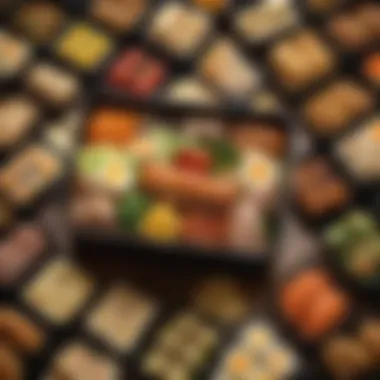

The concept of bento, originating from Japan, has traversed the globe, influencing culinary practices in a myriad of cultures. Its significance extends far beyond mere meal presentation; bento embodies ideas of convenience, nutrition, and aesthetic appeal in dining. This section explores how bento has made its mark internationally, showcasing its relevance and adaptability in diverse culinary landscapes.
Adoption in Other Cultures
As the world grows more interconnected, the exchange of culinary traditions has become commonplace. Bento boxes have caught the eye of various cultures seeking to integrate Japanese aesthetics and efficiency into their meal preparations. In places like Korea, bento has mingled with traditional meal practices, giving rise to unique adaptations. For instance, some Korean lunches now resemble the colorful bento style, incorporating kimchi and rice alongside beautifully arranged vegetables and proteins.
"Bento's journey speaks volumes about globalization, transforming meal experiences by blending cultures in unexpected ways."
In Brazil, bento's influence is evident in the popularization of pre-portioned meals that mirror the visual appeal and balanced components of bento. These meals often include rice, grilled chicken, and a colorful medley of sautéed vegetables. Here, bento-like meals cater to the busy lifestyle while preserving flavors and balance.
Other countries, like the Philippines, have also embraced bento. Local adaptations often include Adobo or Sinigang in vibrant boxes, demonstrating how traditional dishes can find new life in a bento format. The inherent versatility of the bento format allows cultures to embrace their culinary heritage while adopting a visually appealing and organized presentation method.
Bento-Inspired Restaurants
Global culinary trends have given rise to bento-inspired eateries, popping up in cities far from Japan. These establishments often juxtapose traditional bento elements with local flavors, creating hybrid dishes that celebrate both Japanese and local cuisines. For instance, in New York City, many bento restaurants offer a fusion of flavors, such as sushi burritos, which combine the portability and style of bento with the vibrancy of local fresh ingredients.
In London, bento-inspired cafés are catering to health-conscious diners by offering customizable boxes filled with fresh vegetables, grains, and lean proteins. Customers appreciate the ability to choose their ingredients, echoing the bento philosophy of balanced nutrition while making it personal.
Many of these restaurants also emphasize sustainability, with eco-friendly packaging reflecting the growing demand for environmentally responsible dining practices. This is particularly evident in the trend towards reusable bento boxes instead of disposable containers.
Finale
Bento's reach stretches across continents, bringing an intriguing blend of culture and innovation to tables worldwide. Its capacity for adaptation allows it to resonate with various tastes and preferences, making it a culinary marvel. As more people discover the beauty and practicality of bento, it continues to sculpt the future of dining experiences. The lessons learned from bento extend past flavor alone; they beckon culinary enthusiasts to embrace simplicity, balance, and creativity in meal preparation.
Practical Considerations
When it comes to bento food, the notion of practicality cannot be overstated. Understanding practical considerations is crucial for anyone looking to incorporate bento boxes into their daily culinary repertoire. Whether you are a busy professional, a parent juggling responsibilities, or simply someone eager to eat better, the way you approach bento preparation can make a world of difference.
The focus here is multi-faceted: it includes budget-friendly practices and the concept of sustainability, which not only save you money but also align with conscientious living.
At its core, the practical considerations of bento food emphasize efficiency while ensuring that meals remain nutritious and visually appealing.
Preparing Bento on a Budget
Creating a bento box doesn’t have to break the bank. In fact, many traditional bento meals rely on frugality, using available ingredients in ingenious ways. The beauty lies in making the most out of what you already have.
- Utilizing Leftovers: Instead of letting last night's dinner sit idle, repurpose it. Vegetables sautéed with soy sauce or a meat stir-fry can easily find their way into a bento box.
- Seasonal Produce: Buying what’s in season often means you are getting fresh ingredients at a lower price. This practice not only enhances flavor but also promotes local farming.
- Buying in Bulk: By purchasing pantry staples like rice, beans, and grains in larger quantities, you can save money over time. These form the backbone of any good bento box.
- Creative Substitutions: Sometimes, using a less expensive vegetable or protein can help cut costs. For instance, substituting chicken for tofu not only slashes the price but brings a different texture and nutritional profile.
By integrating these budget-friendly strategies, anyone can prepare delightful bento meals without feeling the pinch in their wallets.
Sustainability in Bento Choices
In recent years, sustainability has become the need of the hour. As food waste and environmental concerns have risen alarmingly, revisiting how we prepare and consume meals is imperative. Bento, being inherently flexible, fits well into the sustainability narrative.
- Environmental Impact: Consider sourcing local and organic ingredients to minimize carbon footprints. When you choose local produce, not only do you support your community, but you can also enjoy fresher tastes.
- Reusable Containers: Instead of single-use plastics, invest in quality bento boxes made from durable materials. In the long run, this not only saves money but also lessens waste.
- Minimal Waste Cooking: Focus on utilizing every part of an ingredient. For example, broccoli stems can be sliced thinly and stir-fried just like the florets, thereby avoiding waste and adding variety.
- Mindful Eating Habits: Bento promotes portion control and mindful eating, leading to less food wastage. By filling your box with just the right amount, you increase the likelihood that every morsel will be enjoyed, leaving nothing behind.
"Sustainable practices don’t only contribute to saving the environment but also enhance your culinary experience, making it richer and more connected to the world around you."
In summary, practical considerations in the world of bento transcend mere convenience; they involve smart planning, thoughtful choices, and a conscious effort to create not just meals, but an entire culture of mindful eating and living. Through these approaches, bento not only nourishes the body but also fosters a more sustainable lifestyle.
The End
Reflecting on the importance of bento food transcends mere culinary enjoyment; it encapsulates a layered tapestry of tradition, health, and creativity. This article underscores how bento, while rooted in Japanese history, weaves itself into the lives of people globally, marrying practicality with artistry. The beauty of a bento box lies not just in its aesthetic appeal but also in its capacity to deliver balanced nutrition—making it a darling among health-conscious individuals and busy professionals alike.
Reflecting on the Bento Experience
Engaging with bento food can be a deeply personal experience. For many, preparing a bento is akin to curating a mini art gallery with every meal. The arrangement, the colors, the configuration of tastes and textures—all play a pivotal role. It encourages mindfulness, a pause in the rush of daily life to appreciate the effort that goes into crafting a meal, however simple. Each component, whether it’s a tender chicken teriyaki or a vibrant array of pickled vegetables, speaks volumes of the preparer’s attention to detail.
Furthermore, it’s fascinating how the bento can be personalized to reflect one’s preferences, dietary needs, or cultural influences. Some enthusiast might choose to add kimchi for a spicy Korean twist or opt for vegan options to align with their lifestyle choices. Regardless, the underlying message is one of care—a signal to loved ones that one has taken time to prepare something nutritious and delightful.
Looking Ahead: The Future of Bento Food
As we peer into the future of bento, several trends are shaping its evolution. With the advent of food delivery apps and meal kits, the traditional bento may embrace new forms. Ready-made bento boxes carrying global cuisines are already hitting the markets, making it easier for busy urbanites to enjoy the bento experience without the hassle of preparation.
Moreover, sustainability is gradually becoming a staple topic in the culinary world. The future of bento food emphasizes eco-friendly production, focusing on locally-sourced seasonal ingredients. Consumers are becoming increasingly aware of their environmental impact. Therefore, bento will likely evolve toward incorporating sustainable practices, such as reducing plastic usage and leveraging more reusable containers.
In summary, the narrative of bento food is far from static. It reflects a rich history while constantly adapting to meet contemporary needs and values. As culinary enthusiasts explore these new dimensions, they reaffirm the notion that food is more than mere sustenance; it's a cultural exchange, a vessel of expression, and a celebration of variety that interconnects us all.







